Practice Free MB-500 Exam Online Questions
A company uses Dynamics 365 Finance.
You must add fields to a standard table in Visual Studio.
You need to create an extension of the table.
What should you do?
- A . Create a table extension from the base table.
- B . Create an extension class for the base table.
- C . Create a new table object in the project.
- D . Drag the table from the AOT to the project.
HOTSPOT
You have the following class definition:
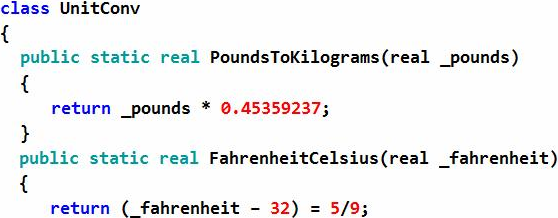
You need to create an extension class and create a new static method in it that converts miles to kilometers and then call the method from another class.
How should you complete the code and call the method? To answer, select the appropriate options in the answer area. NOTE: Each correct selection is worth one point.
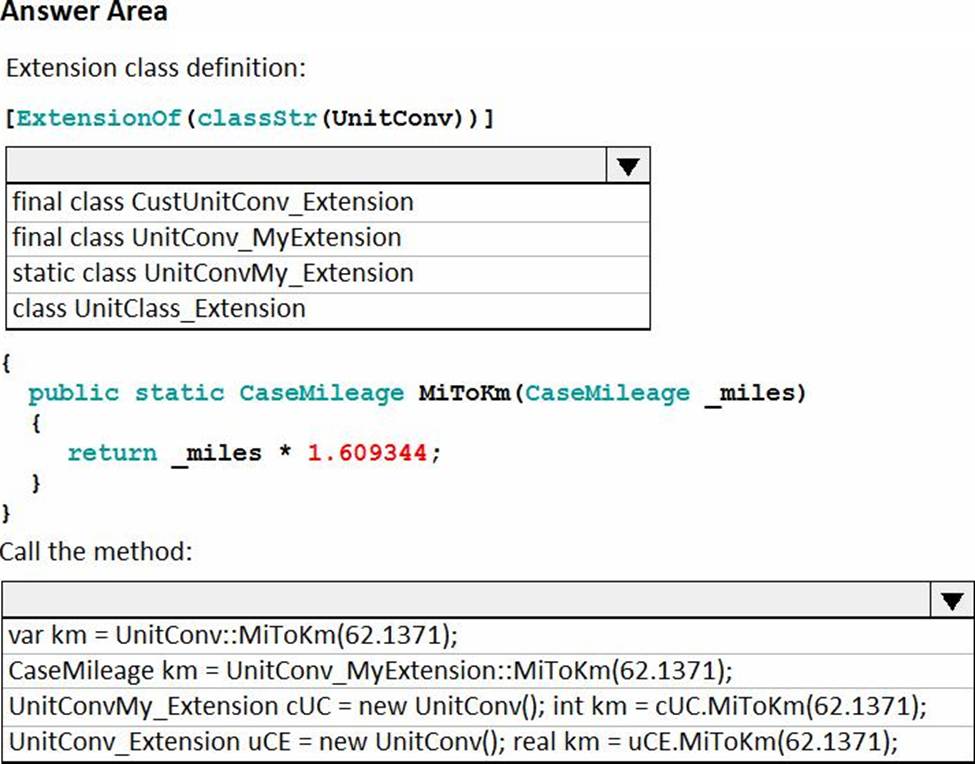
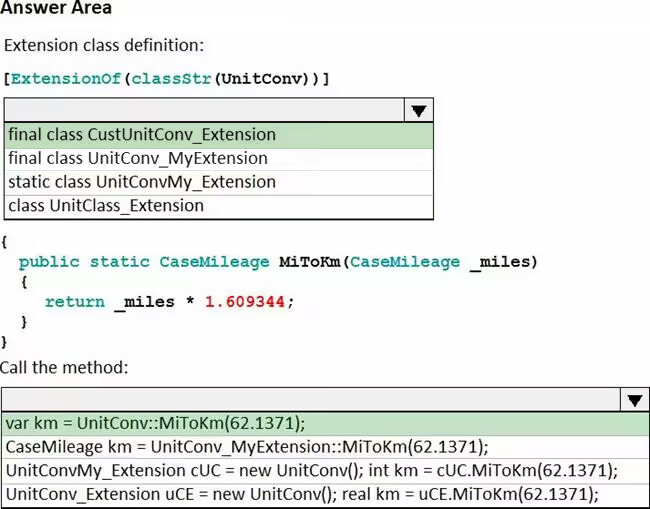
Explanation:
Box 1: final class CustUnitConv_Extension
Box 2: var km = UnitConv::miToKm(62.1371);
Reference: https://docs.microsoft.com/en-us/dynamics365/fin-ops-core/dev-itpro/extensibility/method-wrapping-coc
A company is implementing Dynamics 365 Supply Chain Management.
A developer creates a new form in Visual Studio. The developer must conduct manual unit testing on the functionality of the form before releasing it for functional testing by non-developers.
You need to preview the new form to conduct manual unit testing.
Which action should you conduct first on the form object?
- A . Performance Profiler
- B . Debug
- C . Set as Startup Object
- D . Attach to process
- E . Scope to this
HOTSPOT
You are using the Metadata search tool in Visual Studio.
You need to select the appropriate query string for various scenarios.
Which query string should you use? To answer, select the appropriate options in the answer area. NOTE: Each correct selection is worth one point.
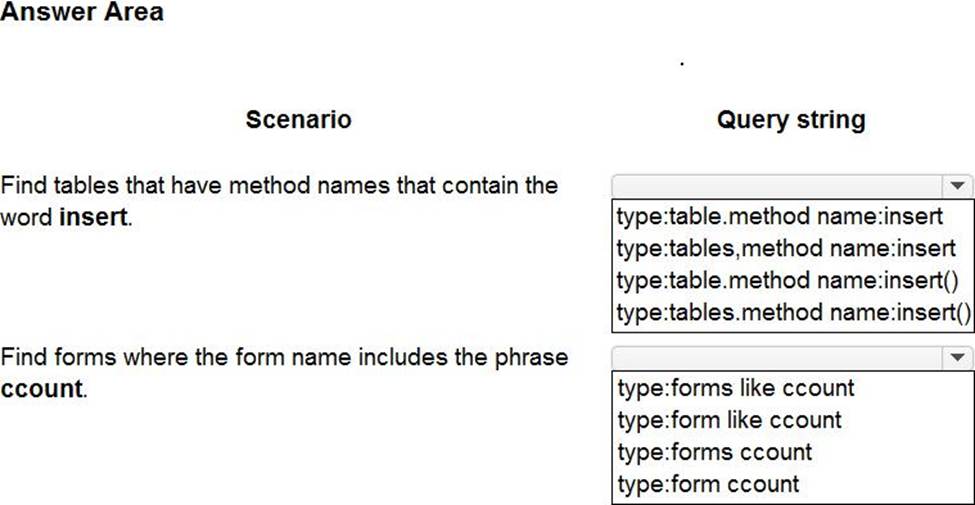
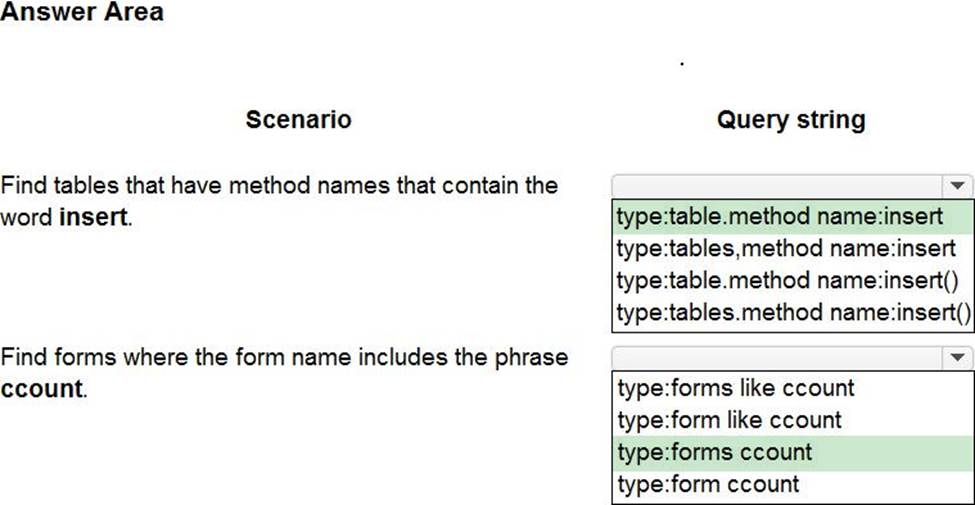
Explanation:
type:table,method name:insert
type:form ccount
https://learn.microsoft.com/en-us/dynamics365/fin-ops-core/dev-itpro/dev-tools/metadata-search-visual-studio
HOTSPOT
You have a Dynamics 365 Finance and Operations environment.
You have the following code: (Line numbers are included for reference only.)
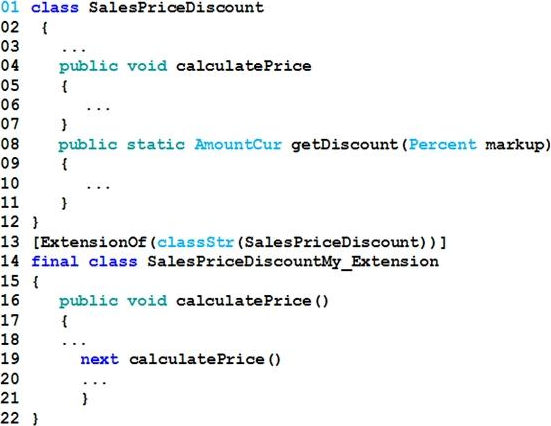
For each of the following statements, select Yes if the statement is true. Otherwise, select No. NOTE: Each correct selection is worth one point.
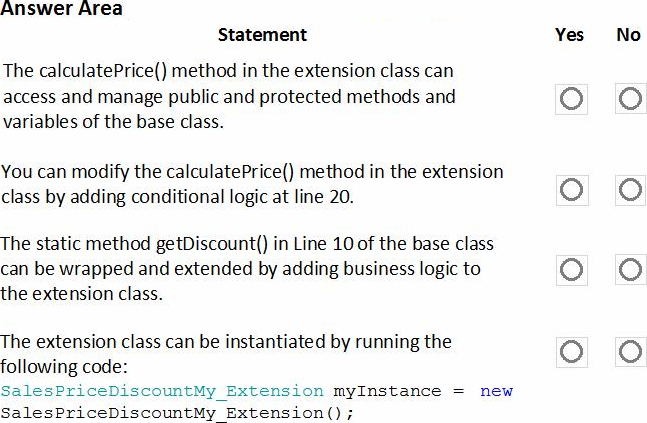
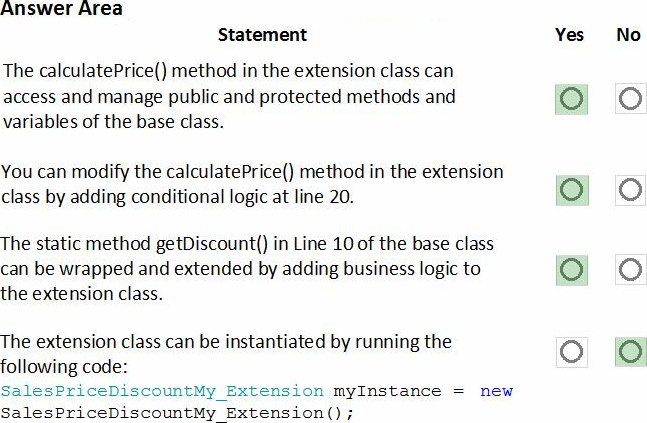
Explanation:
Box 1: Yes
Class extension – Method wrapping and Chain of Command. The functionality for class extension, or class augmentation, has been improved. You can now wrap logic around methods that are defined in the base class that you’re augmenting. You can extend the logic of public and protected methods without having to use event handlers. When you wrap a method, you can also access public and protected methods, and variables of the base class. In this way, you can start transactions and easily manage state variables that are associated with your class.
Box 2: Yes
In the following example, the wrapper around doSomething and the required use of the next keyword create a Chain of Command (CoC) for the method. CoC is a design pattern where a request is handled by a series of receivers. The pattern supports loose coupling of the sender and the receivers [ExtensionOf(classStr(BusinessLogic1))]
final class BusinessLogic1_Extension
{
str doSomething(int arg)
{
// Part 1
var s = next doSomething(arg + 4);
// Part 2
return s;
}
}
Box 3: Yes
Instance and static methods can be wrapped by extension classes. If a static method is the target that will be wrapped, the method in the extension must be qualified by using the static keyword.
Box 4: No
Wrapper methods must always call next.
Note: Wrapper methods in an extension class must always call next, so that the next method in the chain and, finally, the original implementation are always called. This restriction helps guarantee that every method in the chain contributes to the result.
In the current implementation of this restriction, the call to next must be in the first-level statements in the method body.
Here are some important rules:
– Calls to next can’t be done conditionally inside an if statement.
– Calls to next can’t be done in while, do-while, or for loop statements.
– A next statement can’t be preceded by a return statement.
– Because logical expressions are optimized, calls to next can’t occur in logical expressions. At runtime, the execution of the complete expression isn’t guaranteed.
Reference: https://docs.microsoft.com/en-us/dynamics365/fin-ops-core/dev-itpro/extensibility/method-wrapping-coc
A company uses Dynamics 365 Finance.
You are customizing elements for the extended data types (EDTs) shown in the following table.

You have a table named WorkCalendar. The table has a column named BasicCalendailD that uses the BasicCalendarlD EDT. You need to increase the length of the column by using an extension.
Solution: Create an extension for CalendarName.
Does the solution meet the goal?
- A . Yes
- B . No
You need to add new fields to the table for the Inventory Status form to represent the product name and batch ID.
What are two possible ways to achieve this goal? Each correct answer presents a complete solution. NOTE Each correct selection is worth one point.
- A . Drag the EcoResProductName and inventBatchiD extended data types (EDTs) from the Application Object Tree (AOT) to the table. Rename the fields appropriately,
- B . Right-click the newly created table and add two new base enumerations to the table. Rename the new enumerations Product Name and Batch ID respectively.
- C . Right-click the newly created table. Add two new string fields to the table. Rename one string field to Product Name and rename the other to Batch ID. Change the property of the fields to the appropriate EDTs.
- D . Right-click the newly created table in the designer Add a string field named Product Name to the table. Add an enumeration named Batch ID to the table.
You need to add new fields to the table for the Inventory Status form to represent the product name and batch ID.
What are two possible ways to achieve this goal? Each correct answer presents a complete solution. NOTE Each correct selection is worth one point.
- A . Drag the EcoResProductName and inventBatchiD extended data types (EDTs) from the Application Object Tree (AOT) to the table. Rename the fields appropriately,
- B . Right-click the newly created table and add two new base enumerations to the table. Rename the new enumerations Product Name and Batch ID respectively.
- C . Right-click the newly created table. Add two new string fields to the table. Rename one string field to Product Name and rename the other to Batch ID. Change the property of the fields to the appropriate EDTs.
- D . Right-click the newly created table in the designer Add a string field named Product Name to the table. Add an enumeration named Batch ID to the table.
An organization has two million customers that are part of the International customer group.
Validation must occur when customer records are updated. For all customers where the value of the customer group field is international, you must the delivery mode to Air.
You need to update the customer records.
Which two segments can you use? Each correct answer presents a complete solution. NOTE: Each correct selection is worth one point.
A)

B)

C)

D)
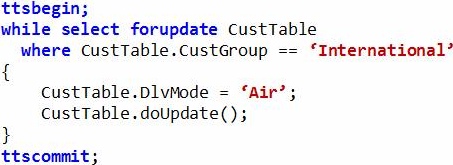
E)

- A . Option A
- B . Option B
- C . Option C
- D . Option D
- E . Option E
AE
Explanation:
Reference: https://community.dynamics.com/ax/b/technicaltutorialsformsdynamicsax2012/posts/update-and-update-recordset-code-sample-in-ax-2012
DRAG DROP
A company uses Dynamics 365 Finance.
The company needs to Hack deletions of purchase order header records only.
You need to enable the change tracking.
Which four actions should you perform in sequence? To answer, move the appropriate actions from the list of actions to the answer area and arrange them in the correct order.


